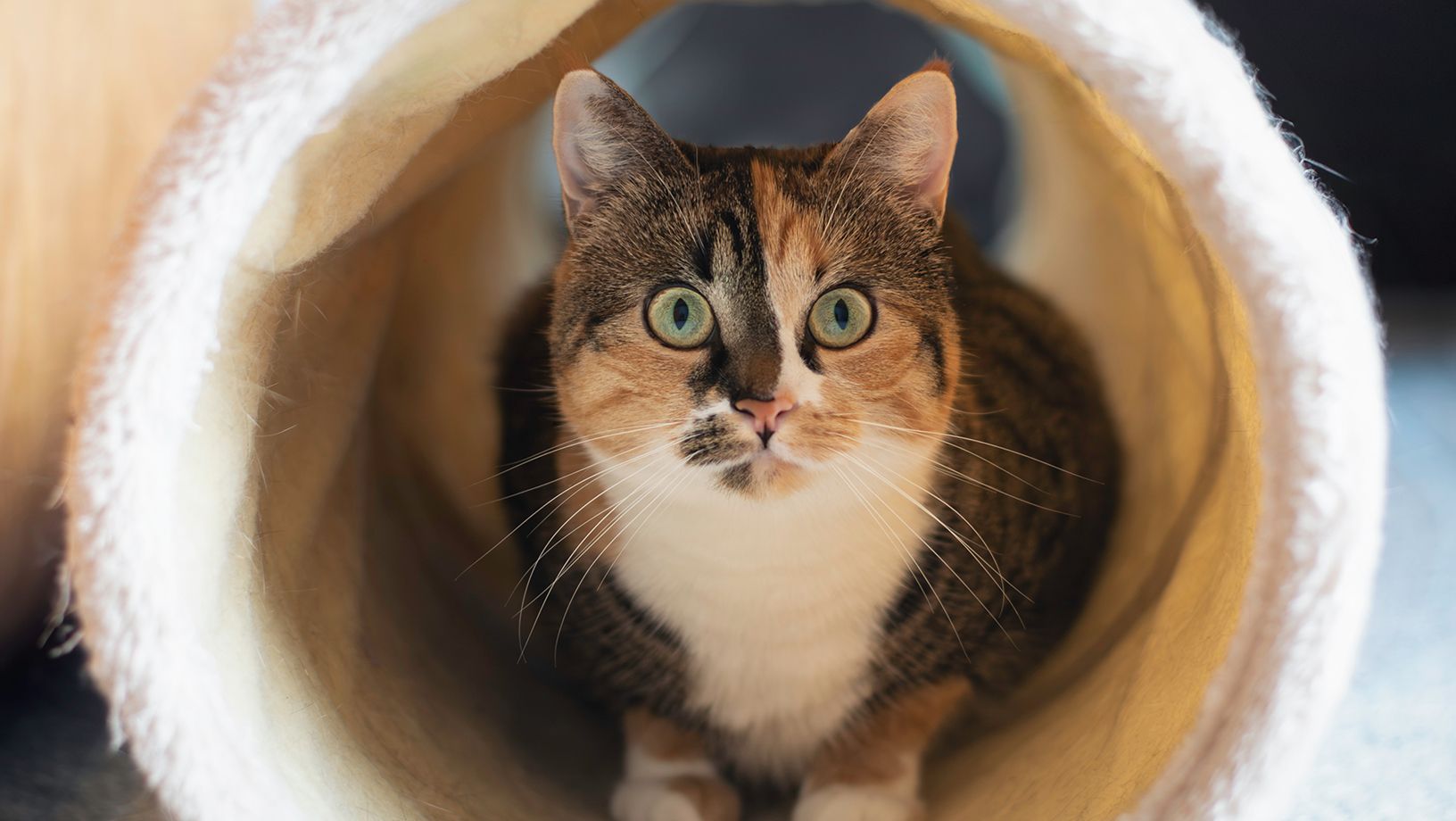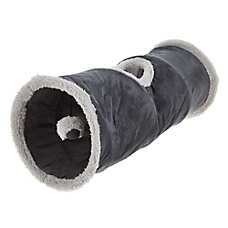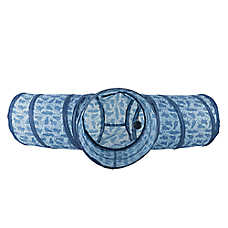The Ins and Outs of Cat Tunnels

In this Article
When you want to give your kitty an interactive cat toy that will bring hours of physical exercise and mental stimulation, a cat tunnel is just the thing. Tunnels satisfy your cat’s natural instinct for exploring and hiding, hunting and stalking, and napping in a safe space. While cat tunnels can be as simple as a large cardboard tube, they can also be as elaborately constructed as a gerbil habitat, with lots of sections that give your kitty hours of fun and enjoyment.
Why cats love tunnels
Cat tunnels offer a safe and cozy environment that appeals to your cat for several reasons:
- Instinct: Tunnels appeal to your kitty’s instinctual need to play, hunt, or relax. Cats are naturally drawn to enclosed spaces like cardboard boxes or tunnels because they offer a sense of security. In the wild, cats frequent tight spaces to stalk their prey or avoid predators, and cat tunnels appeal to these deeply ingrained instincts.
- Entertainment: Tunnels offer an exciting environment for play. Lots of cats enjoy darting in and out of tunnels, hiding from view, then suddenly pouncing on their toys or other “attacking” other cats or people in the house.
- Control: The tight spaces in a cat tunnel give your feline friend a sense of control over their surroundings, making a tunnel a great place to retreat to when they need a break from household hubbub or other pets and humans.
- Exercise: Cats love to move, and darting through tunnels can help keep your cat physically active – an important part of maintaining your cat’s physical fitness, weight and hip and joint health as they grow older.
Types of cat tunnels
There are lots of cat tunnel toys on the market. Their various designs offer different kinds of experiences and different levels of convenience.
- Collapsible tunnels are usually made of nylon or polyester and have a flexible wire frame that can easily collapse down to a small size for storage. These are popular with cat parents because of their portability and convenience.
- Crinkly tunnels are lined with crinkly material that creates sounds when cats move through them. The noise mimics the rustling of leaves or prey and adds an extrasensory element while stimulating your kitty’s hunting instincts.
- Multi-section tunnels have multiple entrances, exits, and branches, giving cats more areas to explore.
- Interactive tunnels come with attached cat toys like dangling balls or feathers that increase engagement.
- Plush tunnels and cat tunnel beds are made of soft or padded material, providing a cozy and comfortable place for cats that like to sleep in an enclosed space.
- Outdoor tunnels are made with durable, weather-resistant material and are designed to allow cats to spend time in backyards and other outdoor spaces.
The benefits of cat tunnels
Cat play tunnels offer lots of advantages for cats and their human parents.
- Mental stimulation: Cat tunnels provide an outlet for curiosity and exploration, helping to keep a cat’s mind sharp and engaged.
- Physical exercise: Running through tunnels and pouncing on toys from secret spaces helps cats stay active – especially important if you don’t let your cat go outside.
- Safety and security: Tunnels provide an intimate, enclosed space where cats can feel safe and hidden – the perfect place to relax or take a nap.
- Social interaction: If you have more than one cat, tunnels can become a great place for chases and interactive play.
- Enabling instinctual behavior: With places to explore and hide, tunnels provide a natural way for cats to exercise their instinctual behavior for hunting, stalking, and pouncing.
Choosing a cat tunnel
Keep these factors in mind when selecting a tunnel for your cat.
- Size: Larger cats will need a bigger space to move around in without feeling cramped, while smaller cats will prefer cozier tunnels that match their size.
- Portability: Collapsible tunnels are a great option if space is a concern or if you frequently travel with your cat.
- Durability: If your cat is rough with their toys, choosing a more durable material is wise. Heavy-duty nylon or polyester, for example, are more resistant to scratching and tearing, ensuring the tunnel will last longer.
- Features: The features you choose depend on what type of activities get your kitty jazzed. After observing your cat’s natural playtime behavior, you might choose a cat tunnel with features like attached toys, crinkly linings, or multiple exits.
FAQs
Are cat tunnels good for cats?
Yes! Tunnels can be highly beneficial for cats. They provide mental stimulation, engage cats’ hunting instincts, prevent boredom, provide exercise and calm your cat’s anxiety.
Are cat tunnels safe?
While cat tunnels are generally safe for cats, it’s important to follow some simple safety guidelines. Choose non-toxic, durable materials that won’t easily tear or fray. This will help prevent your cat from ingesting small pieces of fabric or parts that could harm them. It’s a good idea to supervise your cat’s play with the tunnel at first, in case there’s a risk of getting tangled in toys or in a poorly designed tunnel. And make sure that the tunnel is the appropriate size to prevent your cat from getting stuck or frustrated.
Need other cat supplies while you’re shopping for weight control cat food? PetSmart also carries cat litter, litter boxes, cat toys, cat beds & furniture, cat flea & tick treatments and much more. Explore PetSmart’s Cat Shop to find everything your cat needs, all in one place.
PetSmart offers convenient shopping with Curbside Pickup or in-store pickup. Need something today? We have select items available for Same-Day Delivery in most areas powered by DoorDash.
For items you purchase frequently, PetSmart has Autoship that automatically delivers the items you want to your door as often as you’d like. Check the website to see which items are eligible.
Information in this article is not intended to diagnose, treat or cure your pet and is not a substitute for veterinary care provided by a licensed veterinarian. For any medical or health-related advice concerning the care and treatment of your pet, contact your veterinarian.







